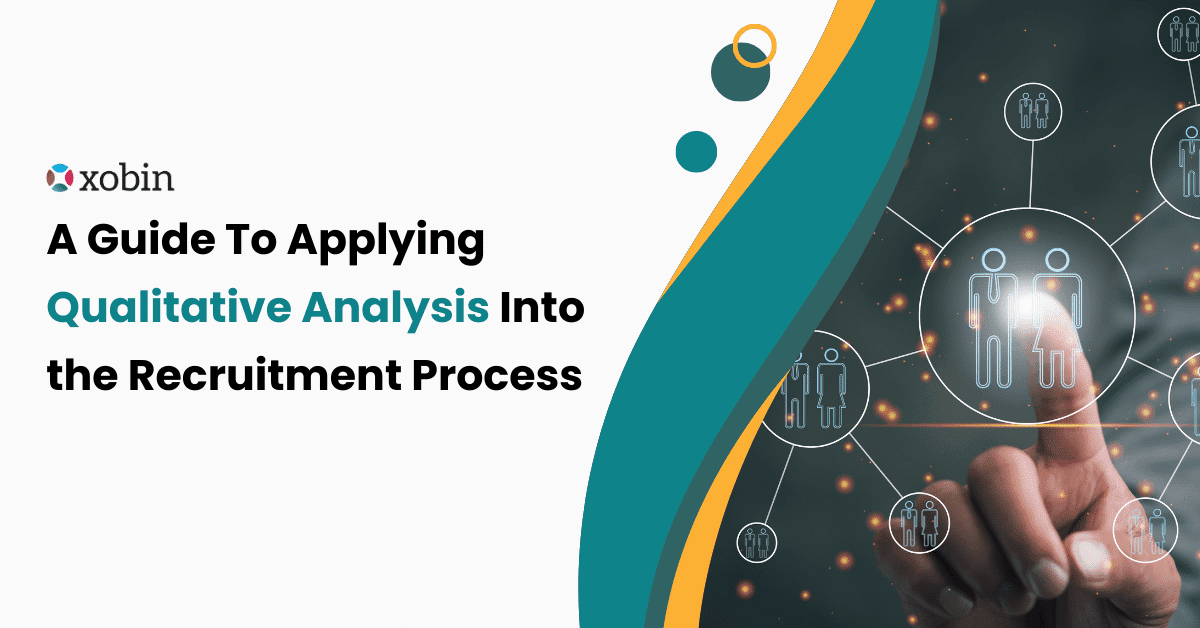With AI transforming hiring, recruitment methods are evolving, challenging traditional candidate evaluations. While quantitative data like assessments offer valuable insights, they miss crucial aspects such as communication, cultural fit, and problem-solving. That’s where qualitative analysis plays a key role. It helps recruiters gain a deeper understanding beyond scores and statistics. Leveraging AI-driven hiring platforms ensures a well-rounded evaluation, balancing data with human insights.
This guide investigates how qualitative analysis can be used throughout the recruitment process, from analyzing interview transcripts to examining verbal reasoning tests more closely. We will explore various qualitative approaches, discuss their advantages, and provide practical tips for implementation.
Table of Contents
Benefits of Using Qualitative Analysis
Qualitative analysis complements quantitative scores by offering profound insights into individual candidates’ unique experiences and motivations. This approach can benefit your recruitment process in several ways:
- Identifies hidden talent
- Reduces bias
- Personalizes the experience
- Uncovers soft skills
By understanding the “why” behind the “what,” one can make informed hiring decisions. It will allow you to build diverse teams and create an engaging experience that attracts the best and brightest candidates.
However, no man is an island, and that applies to the recruitment process. You might need help to maximize the potential benefits of qualitative analysis. You can use qualitative analysis software for efficient coding and theme identification, especially for large datasets. It would be best to involve multiple team members in the analysis to reduce bias and gain diverse perspectives.
Understanding Qualitative Analysis in Recruitment
Qualitative analysis examines textual data, like interview transcripts, responses to open-ended questions, and even facial expressions during interviews, to uncover the following:

Motivations and values
During the hiring process, you should understand what drives candidates and how it aligns with your company’s culture. Thematic analysis can identify patterns across candidate transcripts related to their career goals, company values, and work-life balance preferences. That can help you understand whether candidates are primarily motivated by professional growth, financial stability, or social impact. It will also indicate how well their values align with your company’s mission and core principles.
Narrative analysis considers candidates’ stories about their career trajectory and past experiences. You can uncover their underlying values and aspirations by analyzing their challenges and what motivated their choices. Doing so can help you understand how well they may fit into your company’s culture.
Discourse analysis is also an important HR tech tool that can be used during the. It involves analyzing the language that candidates use when discussing their motivations. This analysis can help you understand whether they use power words related to ambition and achievement or focus on individual accomplishments or teamwork. By understanding their responses, you can reveal intrinsic values and personality traits essential in determining how they may fit into your company’s culture.
Communication skills
To evaluate candidates effectively, analyze their communication skills during the interview. Evaluate their ability to express themselves clearly and concisely and articulate complex ideas. This approach provides insights into their potential to thrive in a professional setting. Content analysis can also be helpful. You can classify language based on jargon, technical terms, or informal language, reflecting communication skills and adaptability.
Another technique is discourse analysis, which involves examining the structure and coherence of their answers. Do they use clear and concise language? Do they make logical transitions between ideas? That can reveal their ability to articulate complex thoughts effectively.
In addition to textual analysis, non-verbal cues can provide essential insights into a candidate’s communication skills. While not strictly textual, analyzing facial expressions, gestures, and body language can reveal much about their confidence, engagement, and emotional state during interviews.
Problem-solving approaches
Observing their thought processes and creativity in finding solutions is essential to understand how they handle challenges. There are several effective methods to analyze problem-solving skills. For instance, grounded theory can help to identify the steps taken by the candidates and the questions they ask. That can reveal their critical thinking abilities and ability to analyze complex situations.
Cognitive skills tests analysis, on the other hand, can help to understand the cognitive skills tested in each interview question or assessment. Analyzing how candidates demonstrate these skills through their responses can demonstrate their analytical thinking, creativity, and ability to think outside the box.
Another method is discourse analysis, which involves examining the language used by candidates to explain their solutions. Analyzing whether they focus on logic and data or use intuition and storytelling can show their preferred problem-solving style and decision-making approach.
Emotional intelligence
To evaluate a candidate’s communication and collaboration skills, you must assess their self-awareness, empathy, and ability to manage emotions effectively. Sentiment analysis can identify the emotional tone of the candidate’s responses. That can help determine their overall emotional state and ability to manage stress. Empathy analysis involves analyzing how candidates respond to hypothetical scenarios or describe their past experiences. It shows their ability to collaborate effectively and build relationships by indicating if they demonstrate empathy for others and consider different perspectives.
Self-awareness analysis involves examining how the candidates reflect on their strengths and weaknesses. That can help determine their self-awareness and ability to learn and grow by demonstrating a realistic understanding of their capabilities and limitations.
Applying Qualitative Analysis
Imagine moving beyond the sterile confines of multiple-choice questions and scores to understand the “why” behind a candidate’s “what.” Qualitative analysis offers valuable insights throughout the recruitment process beyond just analyzing interview transcripts. Here’s how you can leverage it across different stages:
Interview transcripts and reports
Identify recurring themes and keywords: Analyze transcripts to pinpoint common skills, experiences, motivations, and values mentioned by candidates. That helps refine your ideal candidate profile and tailor future interviews. Assess culture fit skills with psychometric tests as well as soft skills so look beyond qualifications to understand communication style, teamwork abilities, and alignment with company culture. Also, identify potential red flags by analyzing for inconsistencies, negative expressions, or lack of enthusiasm to evaluate candidate suitability.
Examples: Problem-solving skills appear repeatedly across transcripts. Consider adding problem-solving scenarios to future interviews. Keyword: “Collaboration” is frequently mentioned. Emphasize teamwork during company presentations to attract culturally aligned candidates. Red flag: A candidate expresses negativity toward previous employers. Explore their reasons and assess potential cultural fit during the interview.
Verbal reasoning tests
Analyze response patterns: Beyond scoring, track how candidates approach complex questions, identify assumptions, and reach conclusions. That reveals critical thinking and analytical skills. Evaluate communication clarity: Analyze written responses for coherence, organization, and ability to convey reasoning effectively.
Examples: A candidate consistently oversimplifies problems in the test, indicating insufficient analytical depth. Another candidate clearly explains their thought process and justifications in written responses. That suggests strong communication skills.
Open-ended questions
With open ended questions uncover motivations and career aspirations by analyzing the responses to delve deeper than resumes. Hence, understand personal drivers, long-term goals, and potential fit within your company’s vision. Also, evaluate soft skills and analyze language and communication style to assess soft skills like teamwork, adaptability, and leadership potential.
Examples: You ask, “What motivates you to excel?” Responses revealing intrinsic motivation suggest potential commitment and engagement. You ask about teamwork experiences. Analyze responses for collaboration skills, conflict resolution strategies, and leadership qualities.
Remember, qualitative analysis is an iterative process. Use insights from one stage to inform the next, continually refining your understanding of ideal candidates and building a more robust recruitment pipeline. However, ensure ethical considerations by anonymizing data and respecting participant privacy.
Best Practices for Qualitative Analysis
Effective qualitative analysis requires careful planning and consideration beyond simply understanding the concepts. Here are five practical tips to guide your journey:
1. Define research questions clearly
Begin by defining your research questions to uncover specific aspects of candidates. Knowing what you’re looking for is essential before delving into the data. Avoid jumping straight into the numbers without a clear understanding of your goals. Your research questions will determine your analysis method and help you gather relevant data. Do you want to understand their motivations for joining your team, their communication skills under pressure, or their problem-solving approach?
2. Pick the right method
Remember that different qualitative methods serve various purposes, just like how a hammer isn’t the best tool for every job. Match the chosen method to your research question and data type. Analyzing interview transcripts requires different approaches compared to open-ended online surveys.
3. Consider ethical standards
Ethical considerations are crucial since qualitative analysis deals with personal data. Before beginning, ensure you have informed consent from candidates. Anonymize data wherever possible and uphold strict data security protocols. Trust and transparency are critical for responsible analysis.
4. Offer training
Skilled interpretation is essential for qualitative analysis, and it’s not magic. Train your team to conduct and interpret the chosen method effectively. Workshops, expert consultations, and practice sessions can equip your team with the necessary tools to draw reliable insights from the data.
5. Pair with quantitative data
Integrating qualitative insights with quantitative data like scores and assessments can help you form a holistic understanding of each candidate. Don’t discard your existing quantitative metrics. The interaction between the two paints a richer picture, guiding you toward informed and well-rounded recruitment decisions.
Quality and Quantity Go Hand in Hand
Qualitative analysis does not seek to replace quantitative data but complements it for a more holistic understanding. Organizations can make informed decisions and build diverse teams by exploring candidates’ narratives, thought processes, and communication styles.
Applying qualitative analysis across the recruitment process can help you move beyond surface-level information. It’s a powerful tool for discovering exceptional candidates who align with your company’s needs and culture. However, it requires ethical considerations, training, and practical implementation to unlock its full potential.






